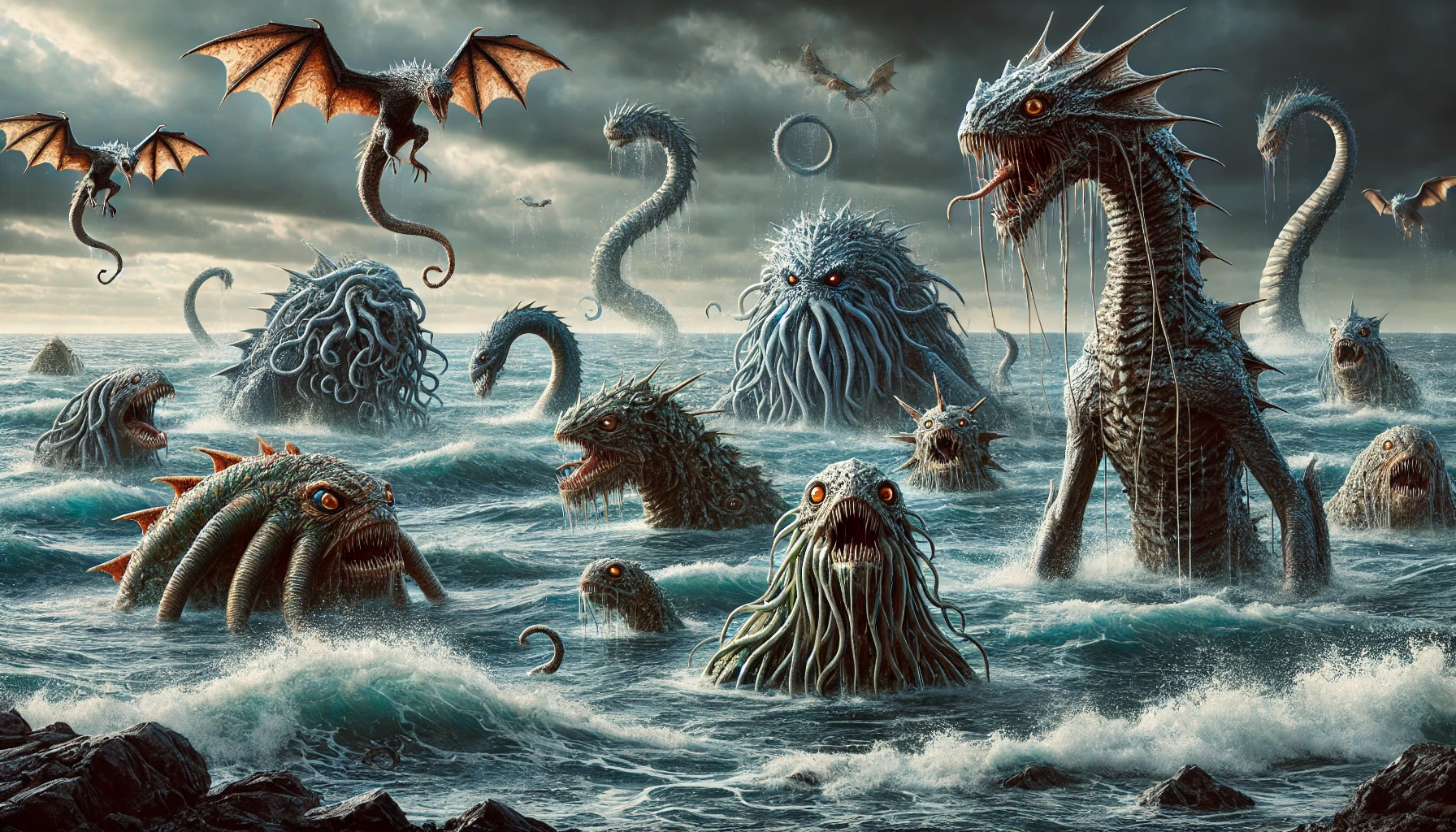Top 5 Mythical Sea Creatures That May Exist: Unveiling Ocean Mysteries
The world's oceans have always been places of mystery and wonder, filled with stories of strange and fantastical creatures. For centuries, sailors and societies have told tales about enormous serpents, half-human sea dwellers, and monstrous beings lurking beneath the waves.
These myths have intrigued and inspired countless generations.

Are there sea monsters hidden in the depths that still elude scientific explanation? This article explores five mythical sea creatures that some believe may exist based on folklore, reported sightings, and the vast, unexplored nature of the ocean.
Dive into the intriguing possibility that these legendary beings could be more than just stories.
1) Kraken
The Kraken is a legendary sea monster known for its enormous size and terrifying appearance.
Originating from Norse mythology, it is often described as a giant squid or octopus with tentacles long enough to drag entire ships into the ocean.
First described in 1180 by the king of Norway, the Kraken's legend has grown over centuries. Some believe sightings of the Kraken were actually encounters with giant squids, which can grow up to 50 feet long.
The Kraken is often depicted as having eyes the size of dinner plates and the ability to engulf ships with its massive limbs. Sailors' tales of this creature have contributed to its fearsome reputation.
The name "Kraken" comes from the Norwegian word "krake," related to the German word for octopus.
While its actual existence remains unproven, the Kraken continues to be a popular subject in literature and film.
In many stories, the Kraken is portrayed as an almost unstoppable force of nature that lurks in the deep waters of the North Atlantic Ocean. Its mythical status is cemented by fascinating and terrifying imagery, making it one of the most well-known sea monsters in history.
2) Leviathan
Leviathan is one of the most well-known mythical sea creatures. It appears in several texts of the Hebrew Bible, such as Psalms, Job, and Isaiah. In these texts, it is often described as a massive and formidable sea serpent or monster.
In religious stories, Leviathan symbolizes God's power. For instance, in Job 41, it represents both a real sea creature and a display of God’s might. Its detailed description highlights its terrifying and unstoppable nature.
Some myths say Leviathan has many heads. In Psalms 74:14, it is a multi-headed serpent vanquished by God. This aspect enhances its image as a fearsome and almost undefeatable beast of the sea.
Unlike other mythical creatures, Leviathan is not just a symbol of chaos. It is also part of creation myths, which shows it having a unique role in ancient stories. Some descriptions even depict it with impenetrable scales, making it seem indestructible.
Leviathan's legend often overlaps with other myths. For instance, it shares similarities with Lotan, a creature from Ugaritic mythology, and with Jörmungandr, the Midgard Serpent from Norse myth. These connections show Leviathan's wide influence across various cultures.
3) Mermaid
Mermaids are mythical sea creatures described as having the upper body of a human and the lower body of a fish. These beings have appeared in folklore from cultures around the world.
In Greek mythology, mermaids are often linked to Sirens, known for their enchanting voices that lured sailors to their doom. Unlike Sirens, however, mermaids are sometimes portrayed as benevolent beings.
In Assyrian myths, Atargatis was considered the first mermaid. She was a goddess closely connected to the sea, with sacred animals including doves and fish. As the chief goddess, she was responsible for the well-being of her people.
Mermaids also feature prominently in European folklore. They were believed to inhabit coastal waters and were sometimes blamed for shipwrecks. However, they were also seen as protectors of the ocean.
In Southeast Asian tales, mermaid princesses were depicted as helpful and kind. These stories highlighted their roles in assisting humans and maintaining the balance of the marine environment.
The idea of mermaids combines fascination with the sea and human imagination. Whether seen as good or evil, they continue to capture the interest of people around the world.
4) Bloop
The Bloop is a fascinating topic when discussing mythical sea creatures. First recorded in 1997, the Bloop was an ultra-low-frequency sound detected by underwater microphones placed across the Pacific Ocean.
This mysterious sound sparked curiosity and numerous theories. Some believed it to be a giant sea creature, like the mythical Cthulhu from literature. The idea of an enormous, undiscovered beast lurking in the ocean captured the imagination of many.
Scientific investigations later revealed that the Bloop was not an unknown sea monster. NOAA scientists discovered that the sound was actually caused by an icequake. An icequake occurs when large pieces of icebergs crack and break away from Antarctic glaciers.
Despite this explanation, the Bloop remains a popular subject in discussions about unknown sea creatures. Its initial mystery fed into many speculative theories, keeping it alive in conversations about what might still be hidden in the ocean's depths.
The Bloop case shows how the unknown can captivate and lead to theories about mythical sea creatures. Even with a scientific explanation, the idea of a sea monster continues to intrigue and inspire.
5) Charybdis

Charybdis is a famous sea monster from Greek mythology. Known as a whirlpool, Charybdis appears in ancient stories alongside another monster, Scylla. The two creatures are located on opposite sides of the Strait of Messina, making this area treacherous for sailors.
In myths, Charybdis would swallow large amounts of water and then belch it out, creating massive whirlpools that could sink ships. Odysseus, Jason, and Aeneas are some of the heroes who encountered Charybdis. They had to choose between facing Charybdis’s whirlpool or Scylla’s many heads.
Modern research links the myth of Charybdis to a real whirlpool in the Strait of Messina. Though this whirlpool exists, it is only dangerous to small boats in extreme conditions. Ancient mariners might have found it perilous, leading to the creation of the Charybdis legend.
Charybdis remains a symbol of a deadly natural force. Her story has persisted through centuries, becoming a classic example of ancient mythology influencing our understanding of natural phenomena. From literature to modern references, Charybdis continues to be a fascinating and feared mythical creature.
Historical Accounts and Legends

Exploring sea creatures often leads us to look back at how ancient cultures and later periods viewed these mysterious beings. From ancient tales to medieval records, each era has its unique beliefs and sightings.
Ancient Mythologies
Ancient civilizations often depicted sea creatures in their folklore and religious texts.
In Greek mythology, the Kraken was a giant sea monster said to dwell off the coasts of Norway and Greenland. It was described as a massive beast capable of sinking ships.
In Babylonian mythology, Tiamat is a primordial sea goddess often depicted as a dragon. Stories suggest she gave birth to the first generation of gods and was later defeated by Marduk.
The Leviathan, from Hebrew scriptures, is another example. This monstrous sea serpent is featured prominently in the Book of Job and is a symbol of chaos and destruction. These myths provide fascinating insights into how ancient societies viewed the power and mystery of the ocean.
Medieval and Renaissance Tales
During the medieval and Renaissance periods, fascination with sea monsters persisted.
Conrad Gessner's Historia Animalium (1604) depicted many sea monsters based on sailors' tales and scholarly interpretations. This included creatures like the Sea Devil, which reflects the era's blend of myth and emerging scientific curiosity.
Medieval maps often marked unexplored waters with the phrase "HIC SUNT DRACONES", meaning “Here be dragons.” This fear of the unknown was visually represented by drawings of various sea creatures.
In Renaissance art and literature, sea monsters often symbolized the dangers of ocean exploration and the mysterious nature of the seas. Stories of mermaids, like those in the works of Christopher Columbus, added to the mystique.
Scientific Perspectives
Scientists approach the topic of mythical sea creatures from various angles, examining both anecdotal evidence and biological possibilities. They analyze reports and compare them with known marine species.
Cryptozoology Studies
Cryptozoology is the study of unknown or hidden animals, often involving the investigation of mythical creatures.
Researchers in this field gather and analyze eyewitness accounts, historical records, and folklore.
They use modern technologies like sonar and deep-sea cameras to search for evidence. For example, the giant squid, once considered a myth, was confirmed when scientists captured footage of it in its natural habitat.
Analyses of myths, like the Norwegian Jörmungandr, reveal how ancient stories might be based on real encounters with large marine life like whales or large fish.
Marine Biology Insights
Marine biologists explore the ocean’s depths to better understand its mysteries.
They study ecosystems and discover new species regularly. Many marine animals, like the giant squid, were unknown until recently.
Bioluminescent creatures and deep-sea fish with unusual features may have inspired tales of sea monsters. Marine biologists also note that ocean currents and weather patterns can create optical illusions that trick sailors into believing they saw mythical beings.
Such studies show how natural phenomena can explain many legendary sea creature sightings. By distinguishing fact from fiction, marine biology provides a clearer picture of what the deep sea truly holds.
Frequently Asked Questions
This section addresses common questions about legendary sea creatures that could have historical or mythological origins.
Which mythical sea creatures have historical evidence suggesting they might have existed?
Several mythical sea creatures might have historical evidence suggesting their existence. The Kraken, often described as a gigantic octopus or squid, possibly originated from sightings of real-life giant squids.
The Leviathan has vague references in ancient texts, hinting it could have been inspired by large sea reptiles like mosasaurs.
What are the names of legendary sea monsters that mariners feared?
Mariners throughout history feared many legendary sea monsters. The Kraken was dreaded for its enormous size and strength.
Charybdis, a monstrous whirlpool, was feared by Greek sailors for its ability to swallow entire ships. The Leviathan was another feared creature mentioned in several ancient texts.
Can you list legendary ocean creatures that are thought to be based on real animals?
Many mythical sea creatures are thought to be based on real animals. Mermaids, for example, might have been inspired by manatees or dugongs. The Kraken closely resembles descriptions of giant squids.
Charybdis’s whirlpool characteristics might be rooted in real whirlpools or maelstroms encountered by sailors.
What are some exquisitely beautiful creatures of the sea from myth and folklore?
Mermaids are often considered some of the most beautiful mythical sea creatures. They are typically depicted as half-human, half-fish beings with enchanting appearances.
Sirens from Greek mythology are also known for their captivating beauty and alluring songs, although they are dangerous.
Among ancient sea legends, which creature is considered the mightiest or most powerful?
In ancient sea legends, the Leviathan is often considered the mightiest and most powerful creature. It was described as a colossal sea serpent capable of great destruction.
The Kraken also holds a place of might due to its tremendous size and strength, able to pull ships into the depths.
Are there any intriguing aquatic creatures that continue to elude scientific explanation?
The Bloop is an intriguing aquatic phenomenon that continues to elude scientific explanation. Detected in 1997, it was an ultra-low-frequency underwater sound that has not been definitively identified.
Some speculate it could be an enormous unknown marine animal, but researchers have not found any conclusive evidence.
Charlie is Editor-in-Chief of Sea Magazine







